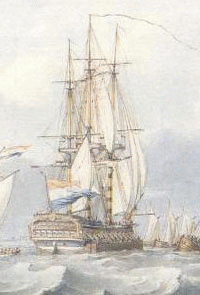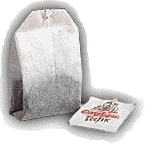|
|||||
|
|||||||
|
    An initiative of :Stichting Food-Info
|
| Food-Info.net> Products > Tea History of teaOriginThe Chinese have been drinking tea for 5,000 years. The beginning is clouded in legend, the most famous of which concerns the Emperor Shen Nung (pronounced Shay-Nung '). His chance discovery of tea is placed in the precise yet historically unfounded year of 2737 BC. The Chinese have been taking tea for health and for enjoyment for thousands of years. No one knows what drew them to the glossy, green leaves of Camellia sinensis, but a popular legend fills the gap in our knowledge. An Indian legend attributes the discovery of tea to the Buddhist monk Bodhidharma. He was understandably tired as a seven-year period of sleepless contemplation drew to an end. In desperation he chewed on some leaves from a nearby tree, and was immediately revived. Another (Japanese) myth about the meditative Buddhist monk, Bodhidharma, describes how he threw his drooping eyelids to the ground in frustration at his inability to say awake. Tea bushes sprang up where the eyelids fell. The leaves of these new bushes miraculously cured his fatigue. The chance method of open-pan tea-making attributed to the Emperor Shen Nung stood the test of time. It was another 4,000 years before the brewing method that we use today was developed. TeaTea' and all its worldwide variations in spelling and pronunciation come from a single source. Te', means tea' in the Chinese Amoy dialect. The Mandarin word for tea, cha', has also spawned a few derivatives around the world. T ea reached Europe in the early seventeenth century. Despite exaggerated claims for its medicinal properties, Europeans preferred the flavour of coffee. It was only amongst a few aristocratic cliques, that tea became popular. Arriving in EuropeEarly seventeenth-century Dutch and Portuguese traders were the first to introduce Chinese tea to Europe. The Portuguese shipped it from the Chinese coastal port of Macao; the Dutch brought it to Europe via Indonesia.  18th century Dutch East India ship The strange brew that came in amongst the cargoes of silks and spices was not an instant success. Europeans tasted it, but preferred the flavour of coffee. The suspicious English waited until 1652 before they even began to trade in tea. The Russians were early devotees of tea. Their tea arrived overland from China by camel train. Royal promotionIn seventeenth century Europe, nothing helped sell a product more than royal patronage. In seventeenth-century Europe, tea was a practical product with great potential. Most water was unfit to drink. For those who wanted to avoid disease, the choice was uninspiring: an exciting cup of boiled water; or beer that was strong enough to kill bacteria. In the eighteenth-century rich homes, tea drinking was an occasion of great ceremony.  (Source) Social life in the first half of the eighteenth century became more sophisticated as coffee houses gave way to tea gardens. The tea gardens came in like a vision of paradise: tree-lined avenues, lantern-lit walks, music, dancing, fireworks, and good food accompanied by a fine cup of tea. Tea consumption increased dramatically during the early nineteenth century. Fashion and reduced costs built a market that suppliers were finding it hard to satisfy. To break the Chinese monopoly, the tea trade looked to India to fill the gap. IndiaAs tea consumption increased in the early nineteenth century, the East India Company looked for new sources of supply. Since the Chinese had a monopoly on tea-growing, the solution was to plant tea elsewhere. PackagingUntil 1826, tea was always sold loose. It was an invitation to unscrupulous shopkeepers to thin the tea out with additives. In 1826 John Horniman developed pre-sealed, lead-lined tea packets, which did not immediately find favour with grocers. They preferred to boost their profits in the time-honoured manner. Horniman then tried a different route to market. He put medicinal messages on the packaging and sold his tea to pharmacists and apothecaries. They and their customers were far more receptive to his approach. Tea bags are said to have arrived by accident. A New York tea importer named Thomas Sullivan sent samples of tea to his customers in small silk bags. The customers clearly liked the convenience because they were soon requesting all their tea in bagged form.  After 5,000 years, tea consumption and production continues to increase. Worldwide, roughly three million tonnes of tea are harvested each year.
|
|
| ||
| Food-Info.net is an initiative of Stichting Food-Info, The Netherlands | ||||||